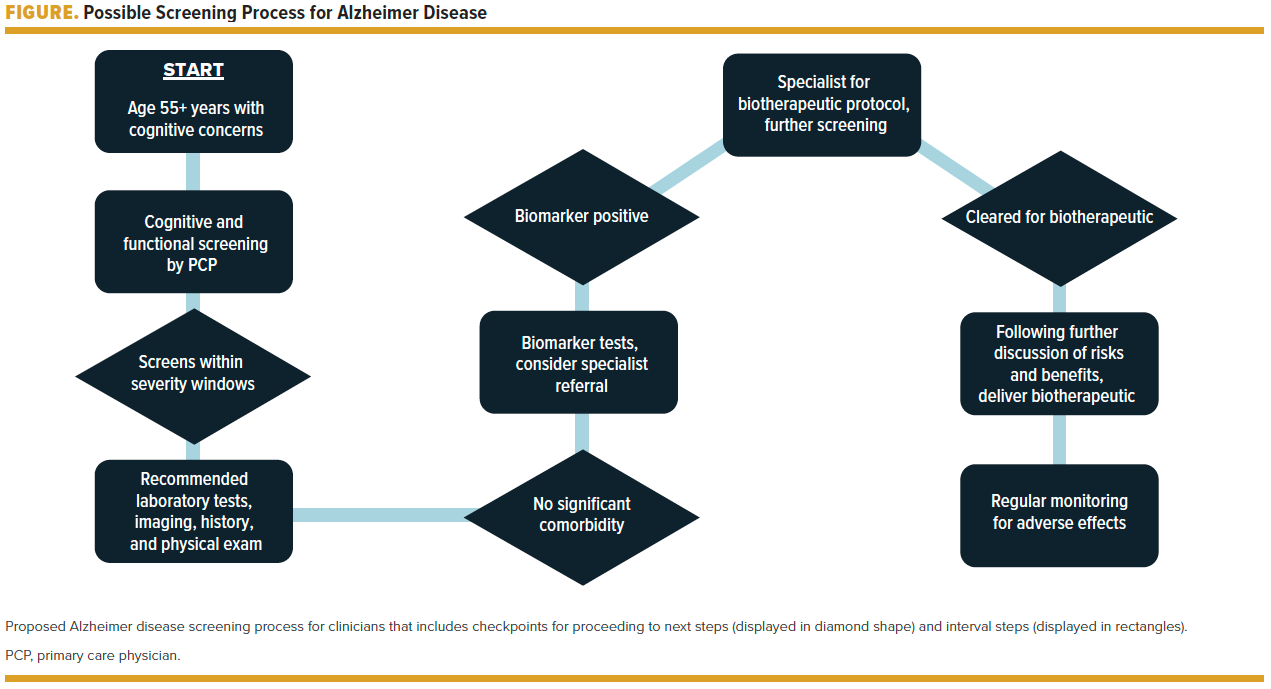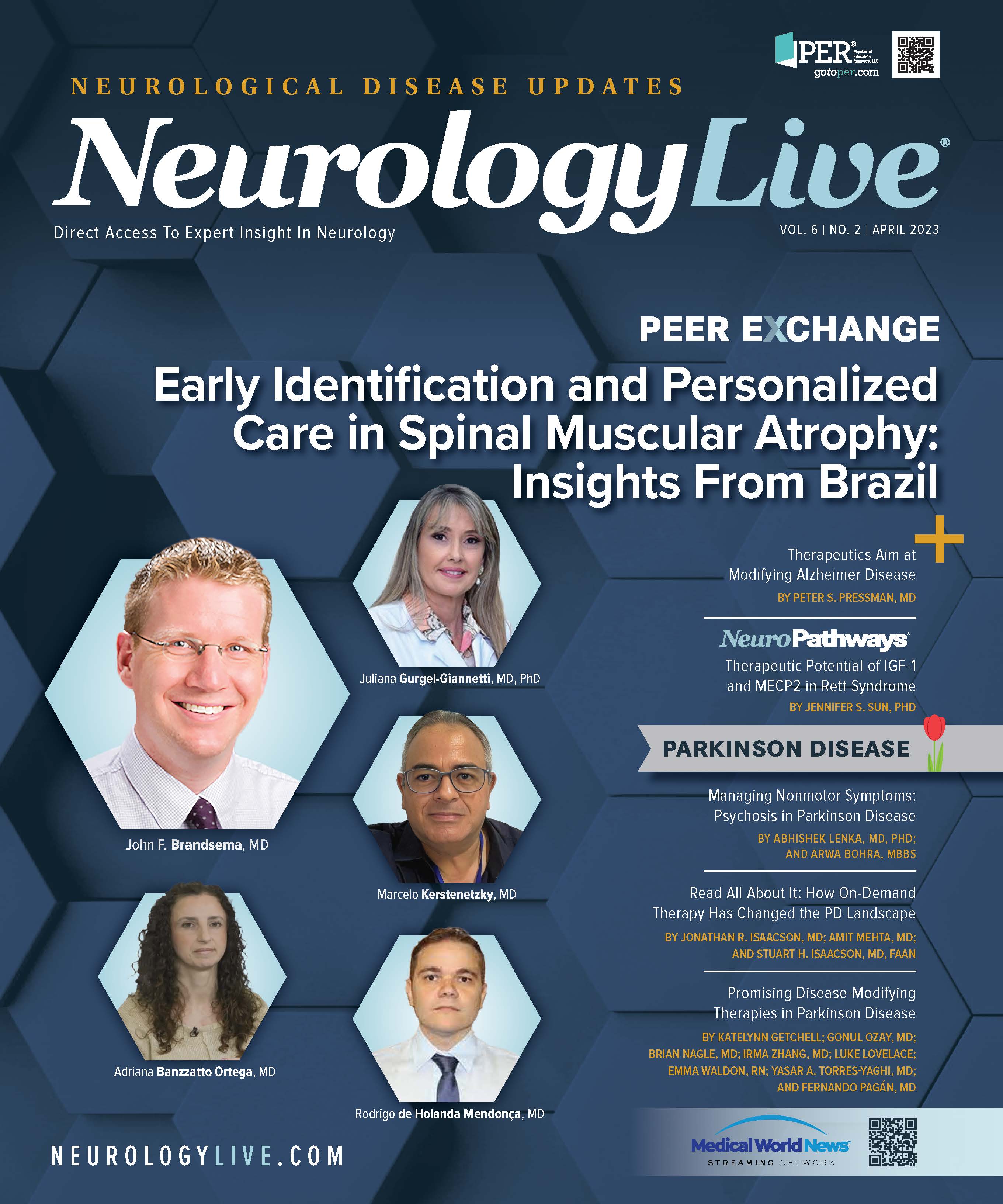AFTER YEARS OF WATCHFUL WAITING, clinicians and investigators have reached new milestones in helping individuals with Alzheimer disease. Therapeutics recently approved by the FDA are not cures1,2 but nevertheless demonstrate progress toward treating disease pathology, rather than managing symptoms, and may encourage further research investment in new agents. Although some of these new therapeutics are surrounded by controversy regarding their approval process, mechanism of action, adverse effects (AEs), and clinical effectiveness, the eventual availability of disease-modifying therapeutics appears more inevitable than hopeless. Given the daunting prevalence of Alzheimer disease and related disorders (ADRDs) such as mild cognitive impairment (MCI), significant changes will be needed to avoid unnecessary delays in therapeutic delivery without further neglecting other aspects of dementia-related care often underserved across the American medical system.
The Rise of Biotherapeutics
In 2021, aducanumab (Aduhelm; Biogen) was approved in a controversial decision by the FDA.2-6 Further research is ongoing to better establish the drug’s efficacy. Although it offered a glimmer of therapeutic hope, the drug’s questionable efficacy, controversial mechanism of action, AE profile, and prohibitive costs curbed patient and provider enthusiasm. In 2022, however, another hopeful note was rung by promising phase 3 results of lecanemab (Leqembi; Eisai) in the Clarity AD trial (NCT03887455),1 followed by lecanemab receiving accelerated FDA approval. Although still not meeting the usual requirements of the FDA, relying instead on amyloid clearance as a putative proxy for disease modification, the lecanemab clinical trial demonstrated up to approximately 6 months of relatively spared function over an 18-month period on some measures. It is uncertain how providers and patients will weigh this benefit vs the increased risk of brain swelling and other significant symptoms on amyloid-lowering drugs (eg, 6.9% of patients taking lecanemab reported AEs leading to discontinuation vs 2.9% taking a placebo), as well as medical costs. However, the Centers for Medicare & Medicaid Services does not yet cover any amyloid-targeting agent outside of clinical trials.
Regardless of these significant uncertainties, a milestone has been reached. A new era in Alzheimer disease management appears to be dawning, with ramifications across all neurocognitive disorders of aging. Success, however tenuous, tends to support more success. Investors previously jumping the Alzheimer ship may be newly encouraged. The terrifying prevalence of the disease suggests an enormous market. In short, more therapeutics will likely come—initially targeting amyloid and then more aspects of the complex Alzheimer pathological cascade.
This raises a critical question. Disease-modifying agents will require early detection, including comprehensive evaluation of disease severity and alternative or confounding diagnoses. When the long-awaited moment arrives, when disease-modifying therapies finally are available for ADRDs…will we be ready?
Current Management of Alzheimer Disease
Even without disease-modifying agents, early detection of ADRDs offers significant benefits, including detecting and managing reversible causes of cognitive decline,1 encouraging lifestyle modifications to significantly reduce Alzheimer risk,7 supporting meaningful engagement in disease-specific planning, and allowing earlier enrollment in clinical trials, all saving billions of health care dollars as our population ages.8,9
Despite these benefits, recognition of Alzheimer disease is often delayed, particularly in underserved communities.10,11 Most initial diagnoses and ongoing management of dementia rely on primary care, the already strained backbone of the American medical system.12 Appropriate diagnosis and comprehensive care of neurocognitive disorders demand time and resources often unavailable to primary care providers at the front lines of ADRD.13-21 Opportunities are lost to formally assess cognition, formally assess severity or decision-making capacity, thoroughly review medications or other possible reversible causes of cognitive decline, evaluate neuropsychiatric and behavioral symptoms, evaluate safety, assess caregiver needs and support, discuss advance care planning, refer to appropriate resources, discuss lifestyle choices relevant to brain health, or otherwise fulfill current guidelines or even incentivize billing codes.22,23 Again, resources are even more limited in underserved populations.
In the face of such significant challenges, it is hardly surprising that early diagnosis of Alzheimer disease and comprehensive care are often deprioritized. More immediate and actionable problems may merit greater attention during the limited medical visit time. Limited resources require triage, and the benefits of early and accurate diagnosis of Alzheimer disease may seem negligible compared with other more-pressing medical needs for which effective treatments and resources are more easily obtained.
Specialty care can dedicate more time, focused expertise, and resources to precise diagnosis and tailored management plans. Several specialties focus on dementia, including geriatrics, neurology, and psychiatry—but these specialists are in short supply, especially if one is searching for focused training in dementia.24,25 Waitlists for these services are already long.
Prolonged waits for comprehensive Alzheimer disease evaluations may have been justified in the past by a lack of clinically meaningful, time-sensitive therapeutics. If there is high demand for emerging biological Alzheimer disease therapeutics, however, significant changes will be needed across the medical system to avoid permitting dementing illness to progress unabetted.
The Challenge
Only a relatively small percentage of individuals with Alzheimer disease will likely be considered good candidates for initial amyloid-targeting therapies.26 Identifying these individuals will require significant time and attention across the medical community, as will treating patients who do not meet criteria for biological therapeutics but have brought attention of their cognitive symptoms to providers who may have previously deprioritized those concerns.
Cognitive screening would be needed to maximize detection of those eligible for novel therapeutics. As many as 77 million individuals in the US have been estimated to be eligible for such screening, the burden of which would likely fall on primary care providers.27 Although eventually this number would decline to match the incidence rates of MCI and dementia, which have been generally falling over recent decades,28,29 initial demand could be significant. Following an initial screening, up to 7.5 million individuals are estimated to need further evaluation by a dementia specialist, with a projected 2 million eligible for the therapeutic.29 That said, it may be that these numbers inadequately consider detection of non-Alzheimer dementia, for which specialty care may be requested.
A possible screening triage system would follow the steps outlined in the FIGURE. Individuals of a certain age with cognitive concerns (or with concerned family members) would alert their primary care provider, who would perform screens for cognitive impairment as well as impact on activities of daily living. These screens would be needed for 2 reasons: to confirm the presence of cognitive impairment and to confirm that this impairment was not already too advanced to consider therapeutics targeting early disease. In addition to standardized tests such as the Montreal Cognitive Assessment, patient-centered outcome measures such as the Functional Activity Questionnaire could be used to objectively assess disease severity related to impact on instrumental activities of daily living.30 Such screens would need to be brief, standardized, and validated across different languages, education levels, and cultures. Furthermore, limits of these tools and their interpretation would need to be understood by those implementing them.31,32
Although some might advocate for immediately screening with an Alzheimer disease biomarker, especially if that biomarker indicated a high chance of disease progression,33 it is still unclear to what extent positive biomarkers in someone with no or mild symptoms will inevitably lead to dementia, and it is possible to have advanced Alzheimer pathology on autopsy without ever having cognitive symptoms.34,35 Given uncertainty of benefit, to consider treatment on biomarker evidence alone would probably require low AE risks as well as low drug costs—requirements that may not be met by the first wave of therapeutics.
For the same reason, for patients with documented cognitive impairment not too advanced for therapeutics—ie, MCI or early dementia—further standard evaluation should still be pursued prior to immediate administration of a biological therapeutic. Especially in early disease stages, it is possible that alternative etiologies or possible comorbidities such as sleep apnea, depression, vitamin B12 deficiency, metabolic disorders, or polypharmacy may be more reversible factors in cognitive decline and offer more clinical meaningful means of improvement. A positive Alzheimer disease biomarker, then, could risk distracting the care team from more fruitful therapeutic approaches. Furthermore, a comprehensive evaluation will be needed to rule out therapeutic contraindications, as well as screen for more immediate dangers in the setting of known cognitive impairment. For example, it would do little good for a patient to be deemed eligible for a biological therapeutic if their cognitive impairment caused a fatal car crash before that therapeutic could be delivered.
As mentioned, cognitive screening and comprehensive evaluation have been difficult to perform in primary care due to limited time, expertise, and other resources. There may be strong incentives, then, to simply proceed to ordering the biomarker screening. Even so, thorough evaluation should remain relevant, whatever the biomarker results.
Specialty consults may see a significant increase in demand in the event of a biological therapeutic. If a biomarker is positive for Alzheimer disease without contraindications or alternative explanation, specialists may be called on to manage treatment administration and subsequent monitoring. If biomarkers are negative for Alzheimer disease, and again no alternative explanation for cognitive change is found, specialists may be asked to evaluate for less common forms of dementia, such as Lewy body dementia or frontotemporal dementia. In any case, demand for specialists can be anticipated to rise. Approximately 7 million referrals have been anticipated,27 though this may be an underestimation. As mentioned, wait times for specialty care are already long and have been projected to exceed 18 months in the advent of a biological therapeutic about which patients and physicians are enthusiastic,27 though this may again be an underestimation.
During this period of waiting, Alzheimer disease would progress unabated. Because this projected wait time is comparable to the duration of the recent trial of lecanemab, we can estimate that every patient on this wait list would miss the approximately 6 months of relatively preserved cognition suggested in the trial while waiting for a specialist appointment.1 Given that 2 million individuals are likely to be eligible for treatment, this allows for an initial cumulative projected opportunity cost of 1 million years of cognition lost due to inefficiencies in medical triage and evaluation.28,29
This initial loss would eventually abate after the initial surge of eligible individuals either received treatment or progressed to the point of ineligibility, allowing a new equilibrium based on Alzheimer incidence alone. However, it would take time to work through the patient backlog, during which time even more otherwise manageable cognitive loss could have been prevented. Such avoidable disease progression merits attention, and that attention will also better prepare the medical system for ongoing dementia care moving forward.
Possible Solutions
The adage “time is brain” stems from a previous neurological therapeutic shift, in which tissue plasminogen activator became deliverable within a certain time of symptom onset to reduce lasting morbidity in stroke. Biological Alzheimer disease therapeutics would operate at a different pace than stroke, but the human cost of delayed care could not be easily ignored in the setting of disease-modifying agents.
Although daunting, obstacles to timely and through evaluation of age-related cognitive changes are not insurmountable. Coverage of antiamyloid therapies has been delayed by the uncertain risk-to-benefit ratio of these new medications and the likely anticipated costs of such a potentially high-demand medication to the medical system. This affords some time for planning, albeit to the understandable frustration of many with Alzheimer disease in the meantime. It is unlikely, though, that even these delays will permit adequate training of new specialists to reduce wait times. A shortage of specialists has been recognized as problematic, and the problem remains unsolved. Alternatives must be further considered.
The first stage of screening and management rests on the straining shoulders of primary care. This burden must be eased. Automated cognitive screens and patient-centered outcome measures may help expedite evaluations of those with cognitive concerns while encouraging adherence to guidelines. Whereas simple algorithms may guide providers, more sophisticated systems—including electronic questionnaires or chatbots—are also feasible. Although such systems cannot replace clinical acumen and care, they may be able to appropriately focus the limited time available during a patient visit rather than requiring physician time be used going through guideline-mandated checklists manually. It is critical that such tools respect the time limitations inherent to primary care—questionnaires that seem brief to dementia specialists may be unwieldy to those who are given less time to manage the entirety of medicine. Similarly, training programs such as Project ECHO are available for primary care providers and will likely perform best when respecting the practicalities of local primary care practice,36 rather than merely promoting well-intentioned but impossible guidelines.21
Additional support for primary care providers may be provided through some intermediate services prior to accessing a dementia specialist. The COVID-19 pandemic expanded access to telemedicine, and home health monitoring systems are increasingly widespread. Electronic consult services may perform further triage as needed.
THE POTENTIAL OF BLOOD TESTS TO IMPROVE SCREENING AND MONITORING IN ALZHEIMER DISEASE CLINICAL TRIALS: RONALD C. PETERSEN, MD, PHD
The director of the Alzheimer’s Disease Research Center at Mayo Clinic detailed issues with the access and affordability of critical biomarkers in the screening and monitoring of patients in Alzheimer disease trials.
View video: neurologylive.com/petersen-ad
If preliminary evaluations are complete by the time a patient is referred to a dementia specialist with a question of appropriateness for aducanumab, such specialists could expand their accessibility and reduce wait times through shorter, focused visits rather than the usual prolonged new consult visits now commonly used. Further adherence to these preliminary requirements could be encouraged by dedicated order sets delineating those prerequisite evaluations. Even when a specialist is not available, adherence to such requirements could facilitate use of semiautomated mutual decision aids to guide practitioners, patients, and families as to the appropriateness of biological therapeutics.37
Throughout each of these steps, attention must be paid to best serving diverse communities. Hispanic/Latino and Black populations are disproportionately affected by Alzheimer disease, and many individuals have difficulty accessing appropriate medical care.38 Creation of novel systems to meet the new opportunity of biological therapeutics may rectify some of these disparities through systemic codesign and by engaging patients and caregivers in the manner they best see fit, hearing their priorities, and ensuring those priorities are met. This includes adequate representation in ongoing trials as well as in biomarkers and screening tests, recommendations tailored to the individual’s situation (reflecting cultural priorities, writing to an appropriate education level, or considering other media for delivering information), and identification of appropriate community partners for all aspects of dementia care.
Summary
Medical practice is subject to the law of supply and demand— limited supply of medical expertise and time to devote to dementia care reflect, in part, hitherto limited demand, in large part because of a perception of helplessness with limited treatment options. A biological therapeutic for Alzheimer disease may alter this perception. It has the potential to rapidly increase demand for dementia-related services in a medical system unprepared to handle the multifaceted, time- and resource-intensive requirements of comprehensive dementia care. Beyond simply triaging for appropriateness of administering biological therapeutics, the medical system has a responsibility to build systems that can provide access to other fundamental aspects of dementia-related care. Such systematic change has the potential to encourage more comprehensive, personalized, and precise care for cognitive aging across our diverse population.
REFERENCES
1. van Dyck CH, Swanson CJ, Aisen P, et al. Lecanemab in early Alzheimer’s disease. N Engl J Med. 2023;388(1):9-21. doi:10.1056/NEJMoa2212948
2. Rabinovici GD. Controversy and progress in Alzheimer’s disease - FDA approval of aducanumab. N Engl J Med. 2021;385(9):771-774. doi:10.1056/NEJMp2111320
3.Alexander GC, Emerson S, Kesselheim AS. Evaluation of aducanumab for Alzheimer disease: scientific evidence and regulatory review involving efficacy, safety, and futility. JAMA. 2021;325(17):1717-1718. doi:10.1001/jama.2021.3854
4. Alexander GC, Karlawish J. The problem of aducanumab for the treatment of Alzheimer disease. Ann Intern Med. 2021;174(9):1303-1304.doi:10.7326/M21-2603
5. Knopman DS, Jones DT, Greicius MD. Failure to demonstrate efficacy of aducanumab: an analysis of the EMERGE and ENGAGE trials as reported by Biogen. Alzheimers Dement. 2021;17(4):696-701.doi:10.1002/alz.12213
6. Mullard A. FDA approval for Biogen’s aducanumab sparks Alzheimer disease firestorm. Nat Rev Drug Discov. 2021;20(7):496. doi:10.1038/d41573-021-00099-3
7. Livingston G, Huntley J, Sommerlad A, et al. Dementia prevention, intervention, and care: 2020 report of the Lancet Commission. Lancet. 2020;396(10248):413-446.doi:10.1016/S0140-6736(20)30367-6
8. Alzheimer’s Association. 2018 Alzheimer’s disease facts and figures. 2018. Accessed March 2, 2023. https://www.alz.org/media/homeoffice/facts%20and%20figures/facts-and-figures.pdf
9. Behrens S, Rattinger G, Schwartz S, et al. Use of FDA approved medications for Alzheimer’s disease in mild dementia is associated with reduced informal costs of care. Int Psychogeriatr. 2018;30(10):1499-1507. doi:10.1017/S104161021800011X
10. Xu WY, Jung J, Retchin SM, Li Y, Roy S. Rural-urban disparities in diagnosis of early-onset dementia. JAMA Netw Open. 2022;5(8):e2225805. doi:10.1001/jamanetworkopen.2022.25805
11. Lang L, Clifford A, Wei L, et al. Prevalence and determinants of undetected dementia in the community: a systematic literature review and a meta-analysis. BMJ Open. 2017;7(2):e011146. doi:10.1136/bmjopen-2016-011146
12. Albert MS, DeKosky ST, Dickson D, et al. The diagnosis of mild cognitive impairment due to Alzheimer’s disease: recommendations from the National Institute on Aging-Alzheimer’s Association workgroups on diagnostic guidelines for Alzheimer’s disease. Alzheimers Dement. 2011;7(3):270-279. doi:10.1016/j.jalz.2011.03.008
13. Harris DP, Chodosh J, Vassar SD, Vickrey BG, Shapiro MF. Primary care providers’ views of challenges and rewards of dementia care relative to other conditions. J Am Geriatr Soc. 2009;57(12):2209-2216. doi:10.1111/j.1532-5415.2009.02572.x
14. Stewart TV, Loskutova N, Galliher JM, et al. Practice patterns, beliefs, and perceived barriers to care regarding dementia: a report from the American Academy of Family Physicians (AAFP) national research network. J Am Board Fam Med. 2014;27(2):275-283. doi:10.3122/jabfm.2014.02.120284
15. Parmar J, Dobbs B, McKay R, et al. Diagnosis and management of dementia in primary care. Can Fam Physician. 2014;60(5):457-465.
16. Hum S, Cohen C, Persaud M, et al. Role expectations in dementia care among family physicians and specialists. Can Geriatr J. 2014;17(3):95-102. doi:10.5770/cgj.17.110
17. Hinton L, Franz CE, Reddy G, Flores Y, Kravitz RL, Barker JC. Practice constraints, behavioral problems, and dementia care: primary care physicians’ perspectives. J Gen Intern Med. 2007;22(11):1487-1492. doi:10.1007/s11606-007-0317-y
18. Salloway S, Sperling R, Fox NC, et al. Two phase 3 trials of bapineuzumab in mild-to-moderate Alzheimer’s disease. N Engl J Med. 2014;370(4):322-333. doi:10.1056/NEJMoa1304839
19. Beach TG, Monsell SE, Phillips LE, Kukull W. Accuracy of the clinical diagnosis of Alzheimer disease at National Institute on Aging Alzheimer Disease Centers, 2005-2010. J Neuropathol Exp Neurol. 2012;71(4):266-273. doi:10.1097/NEN.0b013e31824b211b
20. Qian W, Schweizer T, Munoz D, Fischer C. O3-04-06: misdiagnosis of Alzheimer’s disease, inconsistencies between clinical diagnosis and neuropathological confirmation. Alzheimers Dement. 2016;12(suppl 7, part 6):293. doi:10.1016/j.jalz.2016.06.529
21. Porter J, Boyd C, Skandari MR, Laiteerapong N. Revisiting the time needed to provide adult primary care. J Gen Intern Med. 2023;38(1):147-155. doi:10.1007/s11606-022-07707-x
22. Fazio S, Pace D, Maslow K, Zimmerman S, Kallmyer B. Alzheimer’s Association dementia care practice recommendations. Gerontologist. 2018;58(suppl1):S1-S9. doi:10.1093/geront/gnx182
23. Alzheimer’s Association Expert Task Force. Cognitive assessment and care planning services: Alzheimer’s Association Expert Task Force recommendations and tools for implementation. Accessed March 2, 2023. https://www.alz.org/careplanning/downloads/cms-consensus.pdf
24. Rao A, Eaton R. Dementia neurology deserts and long-term care insurance claims experience in the United States: how does limited supply of neurology specialists correlate with claims experience data? May 2021. Accessed March 1, 2023. https://www.soa.org/498dea/globalassets/assets/files/resources/research-report/2021/2021-dementia-neurology-deserts.pdf
25. Lester PE, Dharmarajan TS, Weinstein E. The looming geriatrician shortage: ramifications and solutions. J Aging Health. 2020;32(9):1052-1062. doi:10.1177/0898264319879325
26. Cummings J, Rabinovici GD, Atri A, et al. Aducanumab: appropriate use recommendations update. J Prev Alzheimers Dis. 2022;9(2):221-230. doi:10.14283/jpad.2022.34.
27. Jodi L. Liu JPH, Hillestad R, Mattke S. Assessing the preparedness of the U.S. health care system infrastructure for an Alzheimer’s treatment. RAND Corporation. 2017. Accessed March 1, 2023. https://www.rand.org/pubs/research_reports/RR2272.html
28. Pase MP, Satizabal CL, Seshadri S. Role of improved vascular health in the declining incidence of dementia.Stroke. 2017;48(7):2013-2020. doi:10.1161/STROKEAHA.117.013369
29. Satizabal C, Beiser AS,Chouraki V, Chêne G, Dufouil C, Seshadri S. Incidence of dementia over three decades in the Framingham Heart Study. N Engl J Med. 2016;374(6):523-532. doi:10.1056/NEJMoa1504327
30. Pfeffer RI, Kurosaki TT, Harrah CH Jr, Chance JM, Filos S. Measurement of functional activities in older adults in the community. J Gerontol. 1982;37(3):323-329. doi:10.1093/geronj/37.3.323
31. Garg D, Gupta A, Agarwal A, et al. Latest trends in outcome measures in dementia and mild cognitive impairment trials. Brain Sci. 2022;12(7):922. doi:10.3390/brainsci12070922
32. Quitoriano J, Hamm RM. In patients suspected of cognitive decline, what is the most accurate in-office screening instrument to determine if there is dementia needing further evaluation and management? J Okla State Med Assoc. 2017;110:454-457.
33. Padala SP, Newhouse PA. Blood-based biomarkers in Alzheimer’s disease: a mini-review. Metab Brain Dis. 2023;38(1):185-193. doi:10.1007/s11011-022-01114-1
34. Bennett DA, Schneider JA, Arvanitakis Z, et al. Neuropathology of older persons without cognitive impairment from two community-based studies. Neurology. 2006;66(12):1837-1844. doi:10.1212/01.wnl.0000219668.47116.e6
35. Knopman DS, Parisi JE, Salviati A, et al. Neuropathology of cognitively normal elderly. J Neuropathol Exp Neurol. 2003;62(11):1087-1095. doi:10.1093/jnen/62.11.1087
36. Lindauer A, Wild K, Natonson A, et al. Dementia 360 ECHO: using technology to facilitate diagnosis and treatment. Gerontol Geriatr Educ. 2022;43(2):202-208. doi:10.1080/02701960.2020.1835658.
37. Davies N, Schiowitz B, Rait G, Vickerstaff V, Sampson EL. Decision aids to support decision-making in dementia care: a systematic review. Int Psychogeriatr. 2019;31(10):1403-1419. doi:10.1017/S1041610219000826
38. Lu K, Xiong X, Li M, Yuan J, Luo Y, Friedman DB. Trends in prevalence, health disparities, and early detection of dementia: a 10-year nationally representative serial cross-sectional and cohort study. Front Public Health. 2023;10:1021010. doi:10.3389/fpubh.2022.1021010








